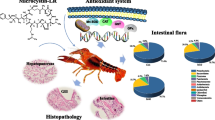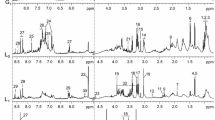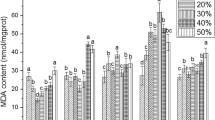Abstract
The role of glutathione (GSH) and cysteine (Cys) conjugates in the detoxification of microcystin-LR (MC-LR) in bighead carp (Aristichthys nobilis) was examined under laboratory and field conditions. Wild individuals of bighead carp were collected from 5 eutrophic lakes along the Yangtze River, while in laboratory experiment, bighead carp were injected intraperitoneally with 500 μg purified MC-LR/kg body weight (bw). Contents of MC-LR and its glutathione (MC-LR-GSH) and cysteine conjugates (MC-LR-Cys) in the liver of bighead carp were determined by liquid chromatography electrospray ionization mass spectrum (LC–ESI–MS). In laboratory experiment, low concentrations of MC-LR-GSH (mean: 0.042 μg/g dry weight (DW)) were always detectable, and the mean ratio of MC-LR-Cys to MC-LR-GSH was 6.55. While, in field study, relatively high MC-LR-Cys concentration (mean: 0.22 μg/g DW) was detected, whereas MC-LR-GSH was occasionally detectable, and the average ratio of MC-LR-Cys to MC-LR-GSH was as high as 71.49. A positive correlation was found between MC-LR-Cys concentration in the liver of bighead carp and MC-LR content in seston from the five lakes (r = 0.85). These results suggest that MC-LR-Cys might be much more important than MC-LR-GSH in the detoxification of MC-LR in fish liver, and that cysteine conjugation of MC-LR might be a physiological mechanism for the phytoplanktivorous bighead carp to counteract toxic cyanobacteria.



Similar content being viewed by others
References
Atencio L, Moreno I, Jos A, Pichardo S, Moyano R, Blanco A, Cameán AM (2008) Dose-dependent antioxidant responses and pathological changes in tenca (Tinca tinca) after acute oral exposure to Microcystis under laboratory conditions. Toxicon 52:1–12
Azevedo SMFO, Carmichael WW, Jochimsen EM, Rinehart KL, Lau S, Shaw GR, Eaglesham GK (2002) Human intoxication by microcystins during renal dialysis treatment in Caruaru-Brazil. Toxicology 181–182:441–446
Bagu JR, Sykes BD, Craig MM, Holmes CFB (1997) A molecular basis for different interactions of marine toxins with protein phosphatase-1, molecular models for bound motuporin, microcystins, okadaic acid and calyculin A. J Biol Chem 272:5087–5097
Blaha L, Kopp R, Simkova K, Mares J (2004) Oxidative stress biomarkers are modulated in silver carp (Hypophthalmichthys molitrix Val) exposed to microcystin-producing cyanobacterial water bloom. Acta Vet Brno 73:477–482
Carmichael WW (2001) Health effects of toxin-producing cyanobacteria: “the CyanoHABs”. Hum Ecol Risk Assess 7:1393–1407
Carmichael WW, Beasly V, Bunner DL, Eloff JN, Falconer I, Gorham P, Harada KI, Krishnamurty T, Min-Juan Y, Moore RE, Rinehart K, Runnegar M, Skulberg OM, Watanabe M (1988) Naming of cyclic heptapeptide toxins of cyanobacteria (blue-green algae). Toxicon 26:971–973
Chasseaud LF (1976) Conjugation with glutathione and mercapturic acid excretion. In: Arias IM, Jakoby WB (eds) Glutathione: metabolism and function. Raven Press, New York, pp 77–114
Chen J, Xie P, Li L, Xu J (2009) First identification of the hepatotoxic microcystins in the serum of a chronically exposed human population together with indication of hepatocellular damage. Toxicol Sci 108:81–89
Dai M, Xie P, Liang GD, Chen J, Lei HH (2008) Simultaneous determination of microcystin-LR and its glutathione conjugate in fish tissues by liquid chromatography-tandem mass spectrometry. J Chromaogr B 862:43–50
Dawson RM (1998) The toxicology of microcystins. Toxicon 36:953–962
Dittmann E, Wiegand C (2006) Cyanobacterial toxins—occurrence, biosynthesis and impact on human affairs. Mol Nutr Food Res 50:7–17
Eriksson JE, Toivola D, Meriluoto JAO, Karaki H, Han Y, Hartshorne D (1990) Hepatocyte deformation induced by cyanobacterial toxins reflects inhibition of protein phosphatase. Biochem Biophys Res Commun 173:1347–1353
Falconer IR, Yeung DSK (1992) Cytoskeletal changes in hepatocytes induced by microcystis toxins and their relation to hyperphosphorylation of cells proteins. Chem Biol Interact 81:181–196
Falconer I, Bartram J, Chorus I, Kuiper-Goodman T, Utkilen H, Burch M, Codd GA (1999) Safe levels and safe practices. In: Chorus I, Bartram J (eds) Toxic cyanobacteria in water—a guide to their public health consequences, monitoring and management. E & FN Spon, London, pp 155–178
Gupta N, Pant SC, Vijayarghavan R, Lakshmana Rao PV (2003) Comparative toxicity evaluation of cyanobacterial cyclic peptide toxin microcystin variants (LR, RR, YR) in mice. Toxicology 188:285–296
Hermansky SJ, Stohs SJ, Eldeen ZM, Roche VF, Mereish KA (1991) Evaluation of potential chemoprotectants against microcystin-LR hepatotoxicity in mice. J Appl Toxicol 11:65–74
Ito E, Takai A, Kondo F, Masui H, Imanishi S, Harada K (2002) Comparison of protein phosphatase inhibitory activity and apparent toxicity of microcystins and related compounds. Toxicon 40:1017–1025
Jochimsen EM, Carmichael WW, An JS, Cardo DM, Cookson ST, Holmes CE, de Antunes MB, de Melo Filho DA, Lyra TM, Barreto VST, Azevedo SFMO, Jarvis WR (1998) Liver failure and death after exposure to microcystins at a haemodialysis center in Brazil. New Engl J Med 338:873–878
Ketterer B, Coles B, Meyer DJ (1983) The role of glutathione in detoxification. Environ Health Persp 49:59–69
Kondo F, Ikai Y, Oka H, Okumura M, Ishikawa N, Harada KI, Matsuura K, Murata H, Suzuki M (1992) Formation, characterization and toxicity of the glutathione and cysteine conjugates of toxic heptapeptide microcystins. Chem Res Toxicol 5:591–596
Kondo F, Matsumoto H, Yamada S, Ishikawa N, Ito E, Nagata S, Ueno Y, Suzuki M, Harada K (1996) Detection and identification of metabolites of microcystins formed in vivo in mouse and rat livers. Chem Res Toxicol 9:1355–1359
Kuiper-Goodman T, Falconer I, Fitzgerald J (1999) Human health aspects. In: Chorus I, Bartram J (eds) Toxic cyanobacteria in water—a guide to public health consequences, monitoring and management. E&FN Spon, London, pp 113–153
Li XY, Liu YD, Song LR, Liu J (2003) Responses of antioxidant systems in the hepatocytes of common carp (Cyprinus carpio L.) to the toxicity of microcystin-LR. Toxicon 42:85–89
Li L, Xie P, Li SX, Qiu T, Guo LG (2007) Sequential ultrastructural and biochemical changes induced in vivo by the hepatotoxic microcystins in liver of the phytoplanktivorous silver carp Hypophthalmichthys molitrix. Comp Biochem Physiol C Toxicol Pharmacol 146:357–367
Li L, Xie P, Guo LG (2010) Antioxidant response in liver of the phytoplanktivorous bighead carp (Aristichthys nobilis) intraperitoneally-injected with extracted microcystins. Fish Physiol Biochem 36:165–172
Magalhães VF, Marinho MM, Domingos P, Oliveira AC, Costa SM, Azevedo LO, Azevedo S (2003) Microcystins (cyanobacteria hepatotoxins) bioaccumulation in fish and crustaceans from Sepetiba Bay. Toxicon 42:289–295
Malbrouck C, Kestemont P (2006) Effects of microcystins on fish. Environ Toxicol Chem 25:72–86
Malbrouck C, Trausch G, Devos P, Kestemont P (2004) Effect of microcystin-LR on protein phosphatase activity in fed and fasted juvenile goldfish Carassius auratus L. Toxicon 43:295–301
Nishiwaki-Matsushima R, Ohta T, Nishiwaki S, Suganuma M, Kohyama K, Ishiwaka T, Carmichael WW, Fujiki H (1992) Liver tumour promotion by the cyanobacterial cyclic peptide toxin microcystin-LR. J Cancer Res Clin Oncol 118:420–424
Park HD, Lwami C (1998) Temperal variabilities of the concentrations of intra- and extracellular microcystin and toxic Microcystis species in a hypereutrophic lake, Lake Suwa, Japan (1991–1994). Environ Toxicol Water Qual 13:61–72
Pflugmacher S, Wiegand C, Oberemm A, Beattie KA, Krause E, Codd GA, Steinberg CEW (1998) Identification of an enzymatically formed glutathione conjugate of the cyanobacterial hepatotoxin microcystin-LR: the first step of detoxication. Biochim Biophys Acta 1425:527–533
Qiu T, Xie P, Ke ZX, Li L (2007) In situ studies on physiological and biochemical responses of four fishes with different trophic levels to toxic cyanobacterial blooms in a large Chinese lake. Toxicon 50:365–376
Song LR, Chen W, Peng L, Wan N, Gan NQ, Zhang XM (2007) Distribution and bioaccumulation of microcystins in water columns: a systematic investigation into the environmental fate and the risks associated with microcystins in Meiliang Bay, Lake Taihu. Water Res 41:2853–2864
Svrcek C, Smith DW (2004) Cyanobacteria toxins and the current state of knowledge on water treatment options: a review. J Environ Eng Sci 3:155–185
Wang SM, Dou HS (1998) Lake in China. Science Press, Beijing, pp 179–299
Xie P, Liu JK (2001) Practical success of biomanipulation using filter-feeding fish to control cyanobacteria blooms: a synthesis of decades of research and application in a subtropical hypereutrophic lake. Sci World J 1:337–356
Xu LH, Chen GS, Chen JP, Xu JM, Zhang YY (1998) Toxic effects of microcystin on fish liver. Acta Hydrobiol Sin 22:378–379 (in Chinese)
Yu SZ (1995) Primary prevention of hepatocellular carcinoma. J Gastroenterol Hepatol 10:674–682
Zhang DW, Xie P, Liu YQ, Qiu T (2009a) Transfer, distribution and bioaccumulation of microcystins in the aquatic food web in Lake Taihu, China, with potential risks to human health. Sci Total Environ 407:2191–2199
Zhang DW, Xie P, Chen J, Dai M, Qiu T, Liu YQ (2009b) Determination of microcystin-LR and its metabolites in snails (Bellamya aeruginosa), shrimps (Macrobrachium nipponensis) and silver carp (Hypophthalmichthys molitrix) from Lake Taihu, China. Chemosphere 76:974–981
Acknowledgments
We wish to give our heartfelt thanks to both the anonymous reviewer and Dr. Shugart for their spending time in handling and improving the manuscript. This research was jointly supported by Ministry of Science and Technology of China (project title: Lake Water Quality, Water Quantity and Biological Resources Investigation in China, grant number 2006FY110600) and State Key Laboratory of Freshwater Ecology and Biotechnology (2008FBZ01).
Author information
Authors and Affiliations
Corresponding author
Rights and permissions
About this article
Cite this article
Zhang, D., Yang, Q., Xie, P. et al. The role of cysteine conjugation in the detoxification of microcystin-LR in liver of bighead carp (Aristichthys nobilis): a field and laboratory study. Ecotoxicology 21, 244–252 (2012). https://doi.org/10.1007/s10646-011-0783-1
Accepted:
Published:
Issue Date:
DOI: https://doi.org/10.1007/s10646-011-0783-1




